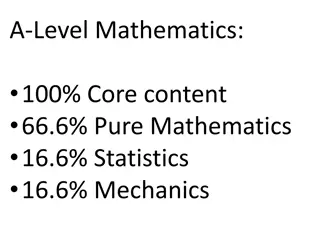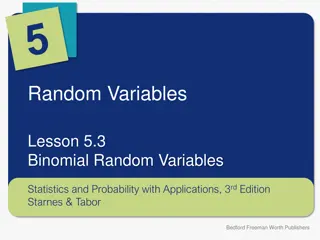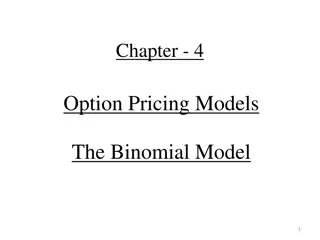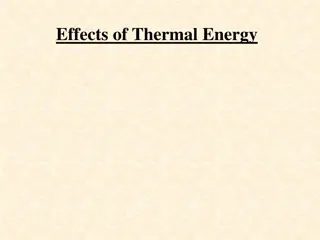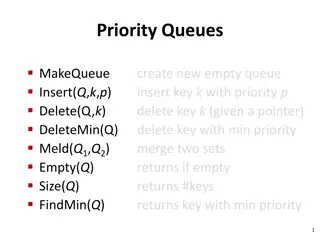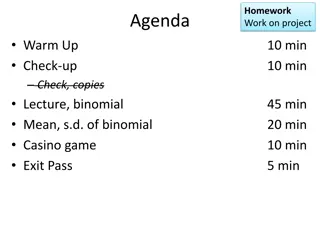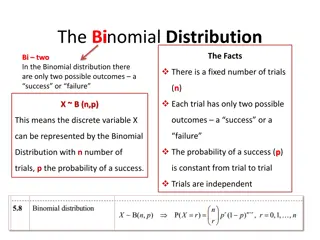Binomial Expansion in Mathematics
This chapter explores binomial expansion, focusing on the coefficients and powers of variables a and b. The expansion follows Pascal's triangle pattern, with coefficients derived from combinatorial principles. Quickfire Pascal exercises demonstrate coefficient patterns for different powers. An example expansion of (x + 2y)^4 illustrates the application of binomial expansion in simplifying expressions.
Download Presentation

Please find below an Image/Link to download the presentation.
The content on the website is provided AS IS for your information and personal use only. It may not be sold, licensed, or shared on other websites without obtaining consent from the author.If you encounter any issues during the download, it is possible that the publisher has removed the file from their server.
You are allowed to download the files provided on this website for personal or commercial use, subject to the condition that they are used lawfully. All files are the property of their respective owners.
The content on the website is provided AS IS for your information and personal use only. It may not be sold, licensed, or shared on other websites without obtaining consent from the author.
E N D
Presentation Transcript
C2: Chapter 5 Binomial Expansion Dr J Frost (jfrost@tiffin.kingston.sch.uk) www.drfrostmaths.com Last modified: 1st September 2015
Starter 1 ? ? ? ? ? Expand (a + b)0 a) b) Expand (a + b)1 c) Expand (a + b)2 d) Expand (a + b)3 e) Expand (a + b)4 1a + 1b 1a2 + 2ab + b2 1a3 + 3a2b + 3ab2 + 1b3 1a4 + 4a3b + 6a2b2 + 4ab3 + b4 What do you notice about: ? ? The coefficients: The powers of a and b: They follow Pascal s triangle. Power of a decreases each time (starting at the power) Power of b increases each time (starting at 0)
Quickfire Pascal What coefficients in your expansion do you use if the power is: 2: 1 2 1 ?
Quickfire Pascal What coefficients in your expansion do you use if the power is: 4: 1 4 6 4 1 ?
Quickfire Pascal What coefficients in your expansion do you use if the power is: 3: 1 3 3 1 ?
Quickfire Pascal What coefficients in your expansion do you use if the power is: 5: 1 5 10 10 5 1 ?
Quickfire Pascal What coefficients in your expansion do you use if the power is: 2: 1 2 1 ?
Quickfire Pascal What coefficients in your expansion do you use if the power is: 4: 1 4 6 4 1 ?
Quickfire Pascal What coefficients in your expansion do you use if the power is: 3: 1 3 3 1 ?
Quickfire Pascal What coefficients in your expansion do you use if the power is: 5: 1 5 10 10 5 1 ?
Quickfire Pascal What coefficients in your expansion do you use if the power is: 4: 1 4 6 4 1 ?
Binomial Expansion (x + 2y)4 = x4 + x3 + x2 + x + (2y) (2y)2 (2y)3 (2y)4 1 4 6 4 1 = x4 + 8x3y + 24x2y2 + 32xy3 + 16y4 Step 1: You could first put in the first term with decreasing powers. Step 2: Put in your second term with increasing powers, starting from 0 (i.e. so that 2y doesn t appear in the first term of the expansion, because the power is 0) Step 3: Add the coefficients according to Pascal s Triangle.
Your go... (2x 5)3 = (2x)3 + 3(2x)2(-5) + 3(2x)(-5)2 + (-5)3 = 8x3 60x2 + 150x 125 ? Bro Tip: If one of the terms in the bracket is negative, the terms in the result will oscillate between positive and negative. The coefficient of x2 in the expansion of (2 cx)3 is 294. Find the possible value(s) of the constant c. (2 cx)3 = 23 + 3 22(-cx) + 3 21(-cx)2 + ... So coefficient of x2 is 6c2 = 294 c = 7 ? Bro Tip: When asked about a particular term, it s helpful to write out the first few terms of the expansion, until you write up to the one needed. There s no point of simplifying the whole expansion!
Exercises Page 79 Exercise 5A 1c, d, g, h 2d, g 3, 4, 6
How are the rows of Pascals Triangle generated? How many ways are there of choosing 0 items from 4? = 4C0 = ? How many ways are there of choosing 1 item from 4? = 4C1 = ? How many ways are there of choosing 2 items from 4? = 4C2 = ? How many ways are there of choosing 3 items from 4? = 4C3 = ? How many ways are there of choosing 4 items from 4? = 4C4 = ? ? ?= ? ? ?= ? ? ?= ? ? ?= ? ? ?= ?
1 1 1 1 2 1 1 3 3 1 1 4 6 4 1 1 5 10 10 5 1
Binomial Coefficients This is known as a binomial coefficient. It can also be written as nCr (said: n choose r ) ? ? ? ? ? ? ? ?
Binomial Coefficients To calculate Binomial Coefficients easily: Because when we divide 8! by 6!, we cancel out all the numbers between 1 and 6 in the product. i.e. The bottom number of the binomial coefficient (2) tells us how many consecutive numbers we multiply together. ? ? ? ? ?
General formula Edexcel May 2013 (Retracted) ?
Using Binomial Expansions for approximations Edexcel Jan 2012 ? If , then x = 0.1. Plugging this in to our expansion: 1 + 0.2 + 0.0175 + 0.00875 = 1.218375 Actual value is (1.025)8 = 1.218403. So it is correct to 4dp!
Using Binomial Expansions for approximations Exercise 5C Write down the first four terms in the expansion of By substituting an appropriate value for x, find an approximate value to (0.99)6. Use your calculator to determine the degree of accuracy of your approximation. Q7 1 0.6x + 0.15x2 0.02x3 0.94148, which is accurate to 5dp ? Write down the first four terms in the expansion of By substituting an appropriate value of x, find an approximate value to (2.1)10. Use your calculator to determine your approximation s degree of accuracy. Q8 1024 + 1024x + 460.8x2 + 122.88x3 1666.56, which is accurate to 3sf ?
Using Binomial Expansions for approximations Edexcel January 2007 a) 1 + 5(-2x) + 10(-2x)2 + 10(-2x)3 = 1 10x + 40x2 80x3 b) We discard the x2 and x3 terms above. (1+x)(1-10x) = 1 10x + x 10x2 = 1 9x 10x2 1- 9x (since we can discard the x2 term again) ? ?

























